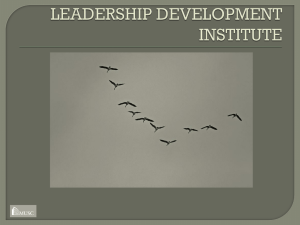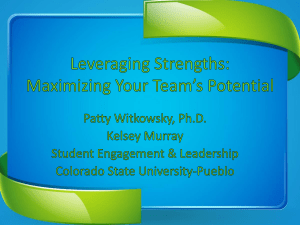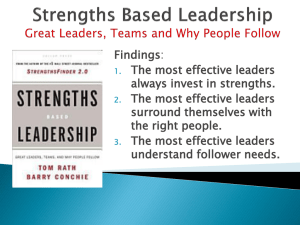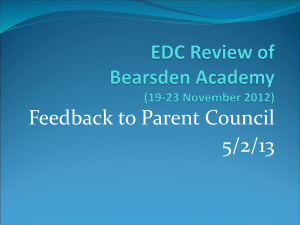StrengthsFinders Presentation
advertisement
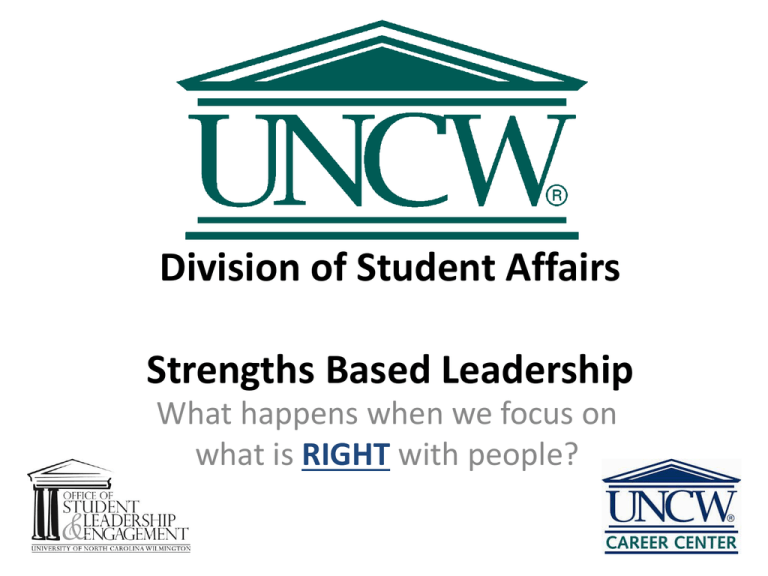
Division of Student Affairs Strengths Based Leadership What happens when we focus on what is RIGHT with people? Why Are We Using StrengthsFinder? We believe that everyone has something to contribute! Rath & Conchie (2008) point out in Strengths Based Leadership: “whether you are taking charge in a boardroom, on a construction site, or even in your home, it is likely that you will find yourself leading at some point in your life.” (p.1) Drucker (1999) challenged people to consider: “what should my contribution be? Given my strengths, my ways of performing, and my values, how can I make the greatest contribution to what needs to be done?” (p.25). StrengthsFinder has proven success. It is used in academic, business, and nonprofit settings; over 2 million people have taken it; it is available in over 24 languages Three Key Findings in Strengths Research 1. The most effective leaders are always investing in strengths. 2. The most effective leaders surround themselves with the right people and then maximize their team. 3. The most effective leaders understand their followers’ needs. StrengthsFinder 2.0 … identifies areas where an individual’s greatest potential for building strengths exists. It is a philosophy of using talents as the basis for consistent achievement of excellence (strengths). Individuals are able to gain far more when they expend effort to build on their greatest talents. If you spend your life trying to be good at everything, you will never be great at anything. PART I: INVESTING IN YOUR STRENGTHS 34 Themes “I’ve never met an effective leader who wasn’t aware of his talents and working to sharpen them” –Former NATO Supreme Allied Commander Wesley Clark Let’s Assess … Person A Strategic Activator Adaptability Maximizer Woo Person B Achiever Learner Input Activator Focus Select A Strength We all lead in very different ways based on our talents and our limitations. Serious problems occur when we think we need to be exactly like [any other] leaders. Using my Strengths, where and how can I contribute to my area and the Division in 2014-2015? [Personal Goal Setting] The most cohesive and successful teams possessed broader groupings of strengths. PART II: MAXIMIZING YOUR TEAM The Four Domains of Leadership Strength Executing • Know how to make things happen; ability to “catch” an idea and make it a reality Influencing • Reach a broader audience; sell the team’s ideas inside and outside the organization Relationship Building • Glue that holds the team together; create groups and organizations that are much greater than the sum of their parts Strategic Thinking • Focused on what could be; absorb and analyze information to make better decisions The Four Domains of Leadership Strength Executing Influencing RelationshipBuilding Strategic-Thinking Achiever Activator Adaptability Analytical Arranger Command Developer Context Belief Communication Connectedness Futuristic Consistency Competition Empathy Ideation Deliberative Maximizer Harmony Input Discipline Self-Assurance Includer Intellection Focus Significance Individualization Learner Responsibility Woo Positivity Strategic Restorative Relator Teams for Large Departments/Offices Campus Life #1 Campus Life #2 HRL #1 HRL #2 Nicole Fedders Amelie Brogden Sean Ahlum Uchenna Baker Sandra Jackson Bill DiNome Al Bright Carrie Hammer Jon Kapell Cynthia Hartmann Danny Hall Matt Herrington Zach Hollenbaugh Alan Hinton Justin Inscoe Tiffani Idol Stefanie Mancuso Nancy Maready Veronica Sills Cassandra Jenkins Larry Wray Amanda Turner Nic Troutman Brad Reid Chris Riendeau Meredith Vaughn Kristen Tucker Clifton Williams Jamar Whitfield Campus Rec #1 Campus Rec #2 Student Health #1 Student Health #2 Thomas Bartolotta Jake Eubank Wendy Bledsoe Rachel Baldwin Sarah Gilbert Drew Loso Emily Bridgman Charlie Bay Zach Gilbert Tim McNeilly Mary Canel Becky Buckley David Parker Amanda Wiggins Kathy Hodge Heidi Gierie Leigh Lane Linda Howard Brian Stelzer Walt Laughlin Terry Ismert Nathan Williams Nancy Patz Ranae Roots Country Simmons Trisha Tinney Andy Rampe Katrin Wesner How Do Your Team’s Strengths Work Together? • Based on your self reflection, how do your individual ways of contributing align with your team’s strengths? • Does your team utilize individuals’ strengths well? If so, how? If not, how could you? • Where are you strong as a team? Where might you run into concerns? • How do your team’s strengths serve students? • How do your team’s strengths contribute the Division? The Divisional Snapshot Division of Student Affairs Compiled Strengths 2014 Achiever Arranger Belief Consistency Deliberative Discipline Focus Responsibility Restorative Activator Command Communication Competition Maximizer Self-Assurance Significance Woo Adaptability Connectedness Developer Empathy Harmony Includer Individualization Positivity Relator Analytical Context Futuristic Ideation Input Intellection Learner Strategic 46 43 40 38 30 29 36 33 31 33 28 25 25 22 21 19 19 16 13 14 13 19 18 16 14 11 10 7 20 6 1 2 2 4 If you want to lead, it is critical to know what the people around you need and expect from you. You are only a leader if others follow. PART III: UNDERSTANDING WHY PEOPLE FOLLOW Consider someone you view as a leader and someone you would “follow.” Why would you follow that person? Follower’s Four Basic Needs 1. Trust (honesty, integrity, & respect) 2. Compassion (caring, friendship, happiness, & love) 3. Stability (security, strength, support, & peace) 4. Hope (direction, faith, & guidance) Reflect. Share. Practice. Build. WHAT NOW?? Combining Strengths: Future Uses • • • • Staff Retreats Search Committees Division Committees Connecting with students (classes, organizations, Executive Boards, etc.) Thank You!! Questions? Comments? Sonja Ardoin, Christina Logan, Mike Phillips, Jaime Russell
